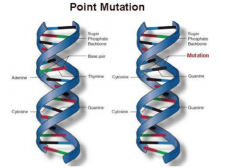![]()
![]()
![]()
Use LEFT and RIGHT arrow keys to navigate between flashcards;
Use UP and DOWN arrow keys to flip the card;
H to show hint;
A reads text to speech;
32 Cards in this Set
- Front
- Back
|
biological evolution |
change in characteristics in a population from one generation to the next (heritable) |
|
|
microevolution |
on a small scale, a single gene change to population over time |
|
|
macroevolution |
large-scale, formation of new species or groups
isolation typically occurs |
|
|
population genetics |
the study of genes and genotypes in a population |
|
|
empirical thought |
relies on observation to form an idea or hypothesis rather than trying to understand life from a non-physcial/spiritual point of view |
|
|
inheritance of acquired characteristics |
behavioral changes modified traits and are then transferred to offspring
thought to occur within a lifetime
by Lamarck from giraffe study |
|
|
catastrophism |
by Georges Cuvier
explains the age of earth (6,000 years) and that catastrophic events shaped it geologically |
|
|
uniformitarianism |
by James Hutton
changes in earth are caused by recurring events like erosion |
|
|
Darwin |
developed theory of natural selection
his ideas stemmed from studying at the galapagos
wrote Origin of Species by means of Natural Slection |
|
|
theory of natural selection |
the ones best at surviving will reproduce more, making their traits more prominent in next generations |
|
|
darwin's evolution theory between generations occurs from two factors: |
genetic variation and natural selection |
|
|
genetic variation |
these variations are from heritable traits being passed on throughout generations |
|
|
Maltus |
wrote Essay on the Principle of Population
populations can only grow according to level of food capacity (population pressure)
food supply is always finite; individuals must compete |
|
|
artificial selection |
humans choosing desirable qualities to breed (selective breeding)
made possible through genetic variation |
|
|
natural selection |
nature will select which traits will survive
1. heritable traits 2. competition = best traits will survive |
|
|
gene expression |
the only changes seen WITHIN an organisms lifetime involve changes of its gene expression; not its genes |
|
|
evidence of biological evolution |
1. study of natural selection 2. fossil record 3. biogeography 4. convergent evolution 5. selective breeding
Homologies 1. anatomical 2. developmental 3. molecular |
|
|
fossil record evidence |
horses changed in anatomy (size,feet,teeth)
is often incomplete but shows a gradual change |
|
|
transitional form |
intermediate between ancestral form and descendant
ex: fish -> fishapod -> tetrapod |
|
|
biogeography |
a spatial record of evolution
environments change and often determine populations |
|
|
endemic |
no species are found in any other area except this one location, often islands |
|
|
convergent evolution |
two species from different lineages have independently evolved similar characteristics due to living in similar environments
ex: anteater and enchidna |
|
|
analogous structures |
convergent traits; the similar traits that two species have despite not being lineage-ly related |
|
|
alleles |
variant forms of a gene, that determine the trait |
|
|
homology |
fundamental similarities due to descent from common ancestor |
|
|
anatomical homology |
having similar structures
ex: arm bones in human, cat, whale, bat |
|
|
homologous structures |
similar structures due to descent from common ancestor |
|
|
vestigial structures |
have no current function but resemble structures of their presumed ancestors |
|
|
developmental homologies |
species that differ enormously at the adult stage, often bear similarities during embryonic development |
|
|
molecular homologies |
a similarity of organisms at the molecular level due to a descent from a common ancestor
all living species use DNA to store info
sequences of closely related species tend to be more similar than to distantly related species |
|
|
what is a necessary pre-req for natural selection |
variation in traits |
|
|
point mutation |

|

